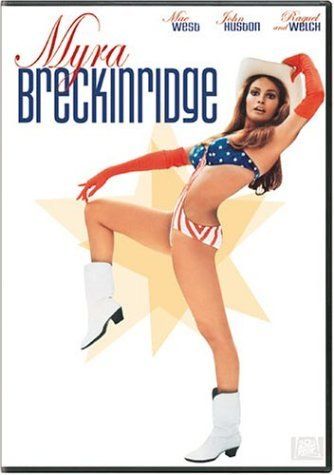Myra Breckenridge (1970) and other good things
At our friend Derick's house for a New Year's Eve party, Bobbie and I were admiring his Coffy poster, and he said "wait here," then disappeared for a minute. When he returned, he presented us with a Foxy Brown poster as a Christmas gift! Very nice. Now I just need to get a nice frame for it.
I'm also incredibly happy to have found the Fox Monie Channel on our cable lineup (at channel 158). It's not as good as TCM, they tend to show a bunch of junk, especially in prime time, but in the off hours they sometimes show some off-beat stuff like Dirty Mary, Crazy Larry and Pickup on South Street. A few weeks ago I taped Beyond the Vally of the Dolls (aka The Greatest Movie Ever Made!) in the small hours of the morning. Hopefully, I'll never have to watch it--word on the street is that a DVD will be out sometime soon, but as far as I know there's no solid release date yet. So at least I have a good copy to replace my third-generation bootleg VHS (I'm not sure whether they showed it completely uncensored, but it was in letterbox, at least).
The next week, I managed to get Myra Breckenridge off of them. I had heard a little bit about this movie, but only had a vague idea that it was a campy movie about a sex change (and at one point, I may have even had it confused in my mind with Mildred Pierce, for whatever reason). In fact, this movie is absolutely fucking insane. I mean, like, Raquel Welch dressed in a Wonder Woman-like costume with a big strap-on fucking a guy up the butt insane! I am not...I repeat NOT...making that up.

"You’re the salvation of this studio. Everyone out there is making their EASY RIDER, and what does Fox have coming out this year? Two war films and a western.”
That quote, allegedly adressed from a Fox executive to Russ Meyer and Roger Ebert, is in reference to Beyond the Valley of the Dolls (the war films and western referenced turned out to be MASH, Patton and Butch Cassidy and the Sundance Kid), but it was likely the same mentality that led to Myra Breckenridge getting made at Fox the same year (the two films share quite a few similarities: both enlisted the talents of a prominent film critic [Rex Reed co-starring in Breckenridge and Roger Ebert writing Beyond the Valley], both deal with issues of amibiguous gender and sexuality, and both begin with an impossibly voluptuous woman arriving in Hollywood to collect half a million dollars from a rich relative). The story revolves around Myron Breckenridge, who gets a sex change to become Myra and promptly pays a visit to her uncle, Buck Loner (John Huston), a washed-up cowboy actor who now runs an acting school from which nobody ever graduates. Myra is ostensibly there to rip him off, but seems more interested in the teaching job he gives her, a chance to lecture her grandiose film theories. "Between the years 1935 and 1945, no insignifigant film was made in America," she tells her students. "Every aspect of human--which is to say, American--mythology was examined." When one student questions her for praising Tarzan and the Amazons, arguing that it doesn't contain "one moment of truth," she responds by asking whether the real Jesus Christ could have possibly been as impressive as his portrayal in King of Kings. If this had been made a few years later, it might have seemed like a rebuking of the realism of 70's cinema. This point of view is echoed in the clever use of old film clips inserted into the film to comment on the action, similar to the old HBO series Dream On. These clips invariably come from the Low Hollywood of Shirley Temple, Carmen Miranda and Laurel & Hardy.
It's a confusing film. For one thing, Myron is played by Rex Reed, and Myra by Raquel Welch, yet they often flip back and forth during a single scene, or have a dialogue with each other. As the film goes on, they seem to become more and more two distinct persons. And there's the question of whether Myron is actually gay in the first place. He is consistently referred to as a "fag," but he seems attracted to a female student, while Myra lusts after a male hunk. Perhaps Myron is bi, but has split himself like Jekyll and Hyde into a male and female half. For that matter, it's often difficult to figure out what exactly is happening. The ending in particular seems to move in some sort of dream logic. Is the whole adventure a dream that Myron has on the operating table? Or a fantasy he weaves while looking out over the balcony of Chateau Marmont? I imagine that Gore Vidal's novel makes all this much clearer, but I think the confusion works in the film's favor. Myra Breckenridge seems to have evolved from some of the more experimental "mod" films of the 60's, like The Magic Christian or Lord Love a Duck, but unlike those films there seems to be more than unintentional sloppiness or artistic overreaching at work here. The film deals so explicitly with gender confusion that it only makes sense for the audience to experience their own disorientation.
I also need to mention Mae West. Well into her 70's (and looking great, all things considered), she delivers her classic schtick as well as she did in the 30's. Certainly a better career-capper than Groucho in Skidoo, she has plenty of great lines, knocks them all out of the park, then takes the stage to belt out Otis Redding's "Hard to Handle!" What more do you want from a movie?

0 Comments:
Post a Comment
<< Home